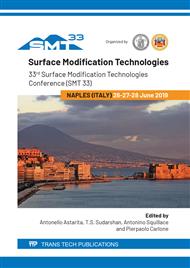p.310
p.316
p.322
p.328
p.334
p.340
p.346
p.352
p.358
Mechanical and Chemical Characterization of Hard Anodized Cooker Grids Made in Al-Si Alloy
Abstract:
In the present work the performances of hard anodized component in Al-Si alloy, used as cooker grids, are described in details. The components have been anodized in H2SO4 at low temperature (less than 0 °C) with a current of about 2.4/dm2 A for 70 min.The effect of the alloy microstructure on the quality of the anodized layer is evidentiated, particularly the Si rich intermetallics inside the metal have a detrimental effect on the performance of the oxidized layer.The components have been analyzed by means of nano-indentation to evaluate the mechanical behavior of the layer. The chemical performances have been studied using Electrochemical Impedance Spectroscopy in different solutions (0.05 M Na2SO4 and 0.01 M NaOH). The results obtained have been correlated with the microstructure of the alloy, furthermore all test have been done, for comparison, on Commercially Pure Aluminum anodized in the same conditions of the Al-Si components.The results indicate that the mechanical properties of the anodized layer of Al-Si components are lower to respect that of Commercially Pure Aluminum.On the contrary the chemical resistance of Al-Si anodized items result poor compared to Commercially Pure Aluminum, in particular the oxidized layer is subject to degradations due to the presence of Si rich inclusions.
Info:
Periodical:
Pages:
334-339
Citation:
Online since:
July 2019
Price:
Сopyright:
© 2019 Trans Tech Publications Ltd. All Rights Reserved
Share:
Citation:


